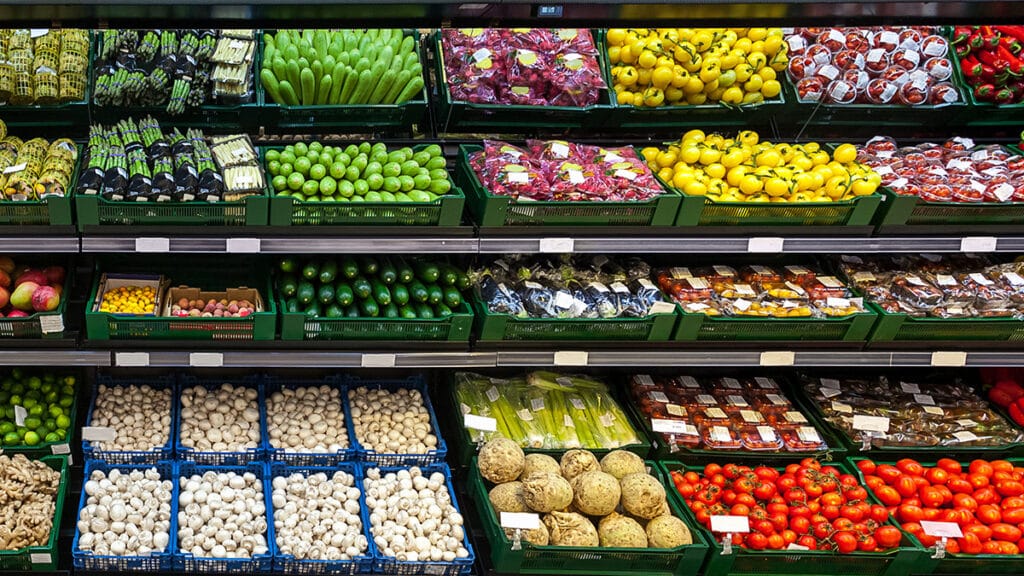The produce supply chain has truly gone global, with consumers now expecting readily available and consistently high-quality fruits and vegetables delivered to their doorsteps via e-commerce platforms or picked off the shelves in local grocery stores. Growers, shippers, and retailers with advanced supply chain strategies are earning consumer loyalty, thanks in part to the supply chain professionals who plan, execute, and adapt to the challenges posed by fresh produce. The journey from the farm to the consumer’s table involves a web of intricate processes and challenges.
In this blog post, you’ll learn about produce supply chain and the key aspects that ensure the delivery of fresh and sustainable produce to our table.
Farm to Table: The Produce Supply Chain
The produce supply chain is a multifaceted network that starts at the source – the farm. The journey typically follows these stages:
Harvesting:
During peak seasons, farms harvest fruits and vegetables at their prime. Timing is critical, as produce must be harvested, cooled, and packaged for transit at peak quality to ensure the best possible flavor, nutritional content, and appearance for the end consumer.
Sorting, Packaging, and Cooling:
Immediately after harvesting, the time sensitive journey to final consumer becomes a race against the clock. Fruits and vegetables begin their next phase along the supply chain. Produce is sorted by size, appearance, and quality to remove damaged or subpar items. Packaging plays a significant role in preserving freshness and preventing damage during transportation.
Supply chain professionals face the challenging task of adapting to changing harvest locations throughout the year, which are influenced by weather patterns.
Transportation:
Produce often travels long distances to reach consumers. Supply chain professionals face the challenging task of adapting to changing harvest locations throughout the year, which are influenced by weather patterns. The primary modes of transport include trucks, ships, and planes. Coordinating these transportation methods and managing the fluctuating demand to ensure sufficient capacity is available for the uninterrupted movement of fruits and vegetables along the supply chain journey can be a complex endeavor.
Distribution Centers:
Most produce passes through distribution centers where it may be further sorted and repackaged for regional or local distribution. These centers serve as key hubs in the supply chain. They are often the last phase prior to produce hitting the shelf. Quantities arriving at a distribution center may come in the form of truckloads, containers, or as part of a multi-stop truckload. The regional distribution center then facilitates the movement of these quantities to the final customers. These are often more frequent and in smaller quantities than most of your general retail items. After all it’s still a race against the ripening clock.
Retailers:
The final leg of the journey involves getting the produce to retailers, such as grocery stores, farmer’s markets, and restaurants. Here, the produce is displayed and made available to the public.
Challenges in the Produce Supply Chain
The produce supply chain is not without its challenges, and these issues can have significant impacts on the quality and availability of fresh produce. Some common challenges include:
The transitional seasons demand the produce supply chain is built to be nimble and adaptable.
Seasonality:
As the name suggests, produce is available only at specific times of the year in each harvest region. This can lead to spikes in demand and challenges in meeting consumer expectations for fresh produce year-round. As we publish this article the massive shift Lactuca sativa and Brassicaceae (just a bunch of fancy monikers for the green stuff – you know, the leafy, crunchy crew: lettuce, kale, broccoli, cauliflower, romaine) from Northern California (summer) to Yuma, Arizona marks the “end” of domestic US produce season. A perfect example of how the transitional seasons demand the produce supply chain is built to be nimble and adaptable.
Year after year, industry veterans develop a “sixth sense” for timing, identifying gaps in supply, and understanding the disruptive effects that accompany these transitional periods. Throughout the year, commodities transition between growing regions, shifting a handful of times from the warmer “summer” months in the northern hemisphere to their “wintertime” harvest in locations such as Mexico, South America, or other distant corners of the globe. Supply chain professionals are balancing limited supply across multiple regions and working to efficiently and cost effectively maximize payload while balancing the need for speed.
Perishability:
Fruits and vegetables are highly perishable, and ensuring their freshness during transportation and storage is of paramount importance. Selecting the right transportation partners can make all the difference in maintaining the integrity of your fresh produce. These partners should have a deep understanding of the unique requirements of fruits and vegetables, from temperature control shipping to proper handling practices.
Whether it’s the journey from farm to market or maintaining optimum conditions in distribution centers and supermarkets, maintaining precise temperature control is the key to ensuring that consumers receive produce that is not only safe to eat but also at its peak flavor and nutritional value.
Temperature Control:
To prevent spoilage and extend the shelf life of these perishable goods, it is essential to choose the proper refrigerated transportation and storage facilities. Whether it’s the journey from farm to market or maintaining optimum conditions in distribution centers and supermarkets, maintaining precise temperature control is the key to ensuring that consumers receive produce that is not only safe to eat but also at its peak flavor and nutritional value.
Sustainability:
There is a growing emphasis on sustainable farming and supply chain practices. Reducing the environmental impact of producing and transporting produce is a major concern.
Supply and Demand Fluctuations:
Supply and demand fluctuations pose a significant challenge in the produce supply chain. Overproduction can lead to excess inventory, which often goes to waste if not promptly sold, incurring economic losses for all stakeholders involved. Conversely, shortages can result in consumers paying higher prices for produce or being unable to find their desired items, which can also have economic consequences. Effective forecasting and communication among industry participants, along with flexible supply chain strategies, are crucial for minimizing food waste and ensuring economic sustainability in the agricultural sector.
Sustainable Practices in Produce Logistics
Sustainability is at the forefront of the modern food industry. Consumers are increasingly conscious of their environmental footprint, and this has led to the adoption of several sustainable practices within the produce supply chain:
Local Sourcing:
Supporting local farms reduces the carbon footprint associated with long-distance transportation. Many consumers prefer locally grown produce for its freshness and support of local economies.
Reduced Packaging:
Eco-friendly packaging, like reusable containers or minimal plastic use, is gaining traction. This helps reduce waste and environmental impact.
Efficient Transportation:
Partnering with transportation providers who offer insights into optimizing routes for sustainability is a strategic approach to enhance the eco-friendliness of the transportation process.
Waste Reduction:
Distribution centers and retailers are focusing on minimizing food waste by implementing better inventory management and donation programs.
Technology Integration:
Advanced technologies like IoT sensors and data analytics are used to monitor produce conditions during transportation, helping to ensure that it reaches consumers in optimal condition.
Commitment to Great Quality Produce
With the proper expertise and dedication, ensuring consistent delivery of fresh and high-quality produce to our tables becomes a seamless and reliable process, supporting the overall sustainability of the produce supply chain.
The journey of produce from farm to table involves intricate logistics and supply chain management. Challenges like seasonality and perishability persist, making it essential to choose transportation partners who are committed to understanding the complexities of the produce supply chain. With the proper expertise and dedication, ensuring consistent delivery of fresh and high-quality produce to our tables becomes a seamless and reliable process, supporting the overall sustainability of the produce supply chain.





